Introduction to Bed Bugs
Bed Bugs The common bed bug has long been a pest – feeding on blood, causing itchy bites and generally irritating their human hosts. The Environmental Protection Agency (EPA), the Centers for Disease Control and Prevention (CDC), and the United States Department of Agriculture (USDA) all consider bed bugs a public health pest.
However, unlike most public health pests, bed bugs are not known to transmit or spread disease.
 They can, however, cause other public health issues, so it’s important to pay close attention to preventing and controlling bed bugs.
They can, however, cause other public health issues, so it’s important to pay close attention to preventing and controlling bed bugs.
Bed Bugs Appearance and Life Cycle
Adult bed bugs, in general, are:
- about the size of an apple seed (5-7 mm or 3/16 - 1/4 inch long);
- long and brown, with a flat, oval-shaped body (if not fed recently);
- balloon-like, reddish-brown, and more elongated (if fed recently);
- a “true bug” (characteristics of true bugs include a beak with three segments; antenna that have four parts; wings that are not used for flying; and short, golden-colored hairs); and
- smelly, with a “musty-sweetish” odor produced through glands on the lower side of the body. Young bed bugs (also called nymphs), in general, are:
- smaller, translucent or whitish-yellow in color; and
- if not recently fed, can be nearly invisible to the naked eye because of coloring and size. Bed bug eggs, in general, are:
- tiny, the size of a pinhead;
- pearl-white in color; and
- marked by an eye spot if more than five days old.

Bed Bug Life Cycle
- Eggs (1mm).
- 1st stage nymph (1.5 mm).
- 2nd stage nymph (2 mm).
- 3rd stage nymph (2.5 mm).
- 4th stage nymph (3 mm).
- 5th stage nymph (4.5 mm).
- Unfed adult female.
- Unfed adult male.
The life cycle of a bed bug is shown in the photograph below. During its lifetime, a bed bug will go through the following stages (Starting from the top left, moving counter-clockwise):
Behavior, Diet & Habits
Bed bugs only feed on blood. Under cool conditions, bed bugs have been able to survive up to a year without a meal. They prefer to be more active at night when the host is asleep.
Bed bugs are found in cracks and crevices, including mattress seams, sheets, furniture, behind baseboards, electrical outlet plates and picture frames. Often found in hotels, where they can travel from room to room and in visitors’ luggage or other personal belongings such as purses and briefcases.
How do you get bed bugs?
You can pick up bed bugs almost anywhere — offices, stores, hotels and gyms for starters. They’re great at hiding and have been known to hitchhike in luggage, personal belongings or even you. Once indoors, they can be very difficult to control without the help of an experienced pest specialist. You can reduce your chances of a costly bed bug infestation by catching them early.
Tips
- Remove all clutter from your home, which makes finding bed bugs easier.
- Wash and dry your bed linens on the hottest temperature permitted.
- Closely inspect any second-hand furniture before bringing it in your home.
- Inspect your home after moving, trips, service calls or overnight guests.
